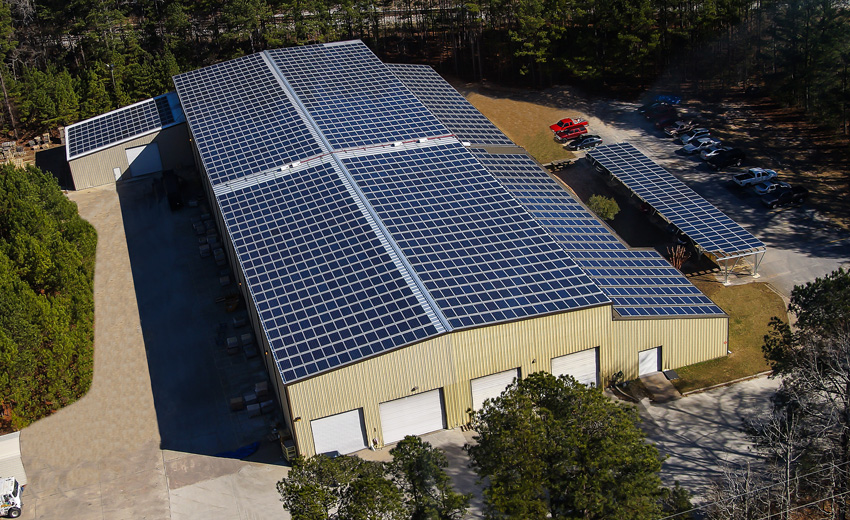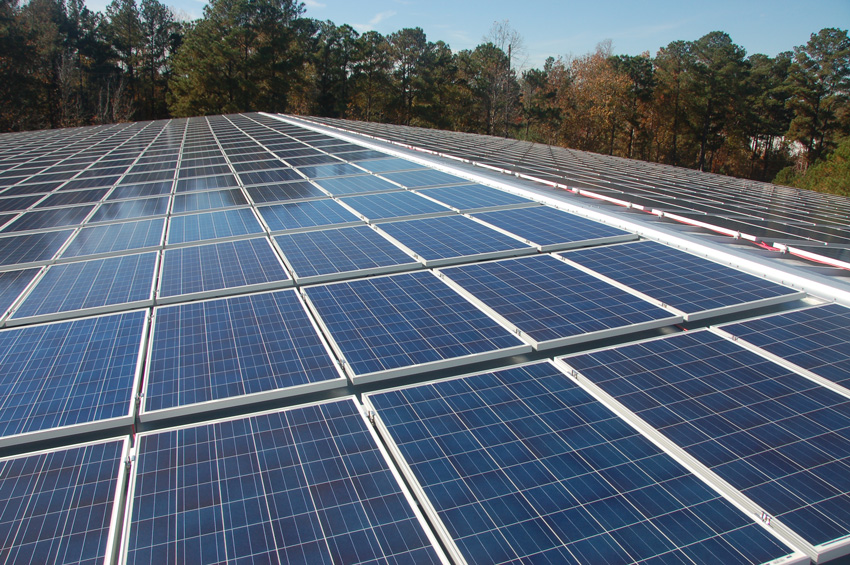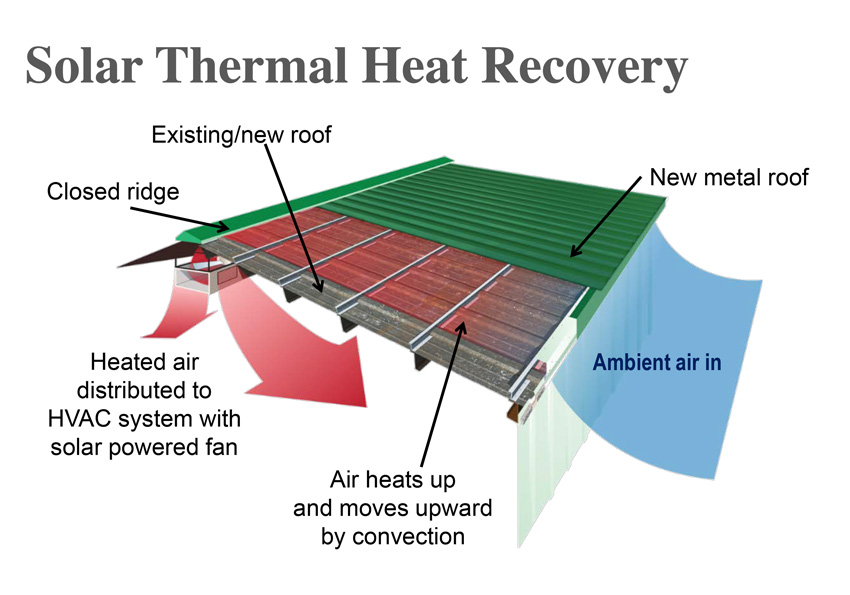Put the Pedal to the Metal
Metal Roofing and Solar Technologies
As a most gracious host for rooftop solar systems, perhaps the most significant benefit that metal roofing systems have to offer is longevity. Whereas all other rooftop materials—including EPDM, BUR gravel, TPO, and modified bitumen—deliver an average service life of 20 years, metal roofs keep on ticking for 40 to 60 years. Naturally, this has significant ramifications on the economies of solar technologies.
For example, in a market survey of building owners conducted by the Troy, Michigan-based market research firm Ducker Worldwide, metal roofs were reported to last 41.6 years, as compared to 23 years for modified bitumen and BUR. Incidentally, the survey also reported metal roofing maintenance costs at 10 cents per square foot per year, with BUR and modified bitumen costing building owners 17 cents per square foot per year.
In another study, cited in an MCA white paper, “Benefits of Retrofit Roofing,” research from the Colorado Springs-based Metal Roof Advisory Group reported that mounting a PV system on a sloped metal roof can provide savings of 24 percent to 43 percent, as compared to a conventional roof system.11
Significantly contributing to these savings is the fact that non-metal roofing systems require dismantling and reinstalling the PV system when the membrane itself requires replacement. Conversely, with metal roofing systems, the solar equipment will require replacement long before the metal roof needs to be retrofitted.

Photo courtesy of McElroy Metal
The metal roof of McElroy Metal’s manufacturing facility in Peachtree City, Georgia, was ideal for mounting a full set of photovoltaic panels.
Another substantial benefit is that PV systems can be attached to a metal roof without penetrations, thereby boosting the thermal and watertight performance of the building enclosure.
“A standing seam metal roof allows the PV system to be clipped directly to the seams, eliminating the need to penetrate the roof plane and minimizing the opportunity for leaks,” explains C.W. Driver’s Feth. “It is also a more economical attachment system compared to supports attached to the building structure, which are much more labor intensive.”
In fact, in a Roofing magazine article, “Rooftop Equipment Mounting and Penetrations for Low-Slope Standing-Seam Metal Roofs,” Metal Roof Advisory Group President Rob Haddock explains that the first role of thumb in mounting rooftop equipment is to avoid penetrating the membrane whenever possible.12
When the membrane is penetrated, “it not only threatens weather integrity but can also violate the membrane’s thermal-cycling behavior by inadvertently pinning the panel to the structure,” he warns. “Such a point of attachment will fatigue and fail from forces of thermal expansion within a short time.”
Mounting PV Installation
Alternatively, seam-clamping hardware can be utilized to grip the standing seam without puncturing the membrane. And because metal is a rigid, high-tensile material, unlike other roofing materials, the combination of the metal roof and clamping hardware provides a beam-like structure for convenient solar equipment anchorage.
“Seam clamps can provide holding strength of up to several thousand pounds on some profiles and gauges, last the life of the roof, and preserve thermal-cycling characteristics,” says Haddock.
In general, designers should verify that the metal roof can accommodate direct attachment of the PV system. For example, “there may need to be a tighter spacing on the metal roof fasteners to the building substrate to account for the uplift wind force of the PV system,” Haddock adds.
In comparing mounting options, not only do apparatuses systems requiring penetrations compromise building enclosure performance, but they also run a risk of leaking and often void the roofing system warranty.
With ballasted systems, the roofing system adds dead load and the PV equipment can only be mounted on new construction.
Adhesion is another option, but this is only applicable with a new roof or reroof, and this strategy only applies for thin-film solar panels.
Overall, Dustin Haddock, vice president of research and development, S-5!, Colorado Springs, Colorado, points out that a number of factors must be taken into consideration when installing PV systems on metal roofing. “External forces like wind and snow loads, seismic loads, thermal loads, and vibratory loads from building equipment, system integration, roof drainage, access for maintenance, and roof safety must be evaluated,” he says. “It’s important to consult with engineering professionals to ensure the PV system accounts for each and every area.”
Whereas many commercial PV roofing projects will go with standard silicon solar panels, metal roofs, particularly standing seam, support thin-film solar panels as well. Although silicon offers higher efficiencies per square foot, thin-film efficiencies continue to improve. Most notably, they provide a smaller profile and are easy to install.
Made from solar cells with light absorbing layers approximately 350 times smaller than a standard silicon panel, thin film are ideal rooftop installations where available space is limited.
Weighing as little as 7 ounces per square foot, thin-film modules can be installed on low-load-capacity roofs incapable of supporting heavier conventional crystalline panels and rack systems.
This smaller, lower-weight, plug-and-play-type system also delivers a nicer rooftop aesthetic.
Incentives and Credits
According to MCA, a standing seam metal roof with a PV system currently qualifies for federal solar-energy tax credits. These include a rebate of 30 percent for the entire system cost, an accelerated depreciation schedule per the U.S. Internal Revenue Service, and a 50 percent first-year bonus depreciation with the balance depreciated over the next five years.
Projects may qualify for additional state and local tax and utility incentives for solar systems and metal roofing. Details on these programs can be viewed at www.dsireusa.org. DESIRE is operated by the North Carolina Clean Energy Technology Center at N.C. State University and funded by the U.S. Department of Energy.
Metal roofing also gets high marks in the green department for facilitating the use of solar panels. Bill Croucher, director of engineering for Fabral, Lancaster, Pennsylvania, says it is easier to attach solar panels to metal roofs. “A thin-film laminate can be adhered to a metal standing seam roof,” he says. Or, a thin film can be adhered to a flat plate that can then fit on 16-inch or wider standing seam panels. Polycrystalline photovoltaic panels can also be mounted on the structural frame of a flat roof, but with the natural slope of metal roof, a framing system is not necessary.
Metal Manufacturer Installs PV on its Plant Facility
A successful example of solar on metal, McElroy Metal recently installed a 500 kW PV array on its plant roof and carport canopy in Peachtree City, Georgia. As part of a solar initiative program in the state of Georgia, PV generated power is sold back to the regional utility provider, Georgia Power.

Photo courtesy of McElroy Metal
Attaching a 500 kW PV array on its plant roof and carport canopy with a stainless steel mounting disk enabled a penetration-free solar-to-roof attachment for McElroy Metal’s manufacturing facility.
“In general, metal is the best substrate for solar considering that the lifespan of both products match up perfectly,” states Peter Rienks, senior account executive, Inovateus Solar LLC, South Bend, Indiana, the general contractor on this project. “Solar on metal is not a new concept, but it is a growing trend. Solar installers are targeting metal roofs for the long lifespan and ease of installation.”
Further capitalizing on the economies of scale, both the metal replacement roof and PV panels were installed at the same time. In particular, a 34-year-old metal roof was replaced with a galvanized R-panel symmetrical standing seam system, and 1,960 solar panels were installed on the new metal membrane.
As opposed to conventional standing seam systems, the installed panel system had matching left and right seams joined with a mechanically seamed cap. At 2 feet per panel, erection proceeded along at a faster clip as more square feet were covered per panel, according to David Dodge, president, Paramount Metal Systems, Little Rock, Arkansas, the project’s rooftop installer. In fact, the crew was able to cover an average of 5,000 square feet per day. In the end, the 30,000 square-foot metal installation took approximately eight days.
Next, the solar panels were installed in 2½ weeks. To attach the solar panels, three different clamps were used—one for the metal panels, one for an existing through-fastened panel on the facility, and a third for another existing standing seam panel. As opposed to traditional rail or rack attachment methods, which penetrate the rooftop membrane, the PV array was attached with a new stainless steel mounting disk, enabling a penetration-free solar to roof attachment.
Furthermore, a 3½-inch retrofit clip elevated the height of the new roofing system to the top of the existing panels. Nestled between the ribs of the existing roof, the clip essentially eliminated the need for subframing, thereby reducing material and labor expenses.
Inside the space created by the clip, foam insulation was installed, thereby raising the roof’s R-value and lending additional support to the roof panels. “Everybody in the field was pleased with the installation. I don’t think it could have gone any better. The entire project took six weeks,” reports Dodge.
Cashing in on Metal Retrofits
As previously noted, Feth reiterates that metal delivers a much longer service life than shingles, built up roofing, or single-ply roofing. With replacement happening less frequently, this lessens the impact on old roof materials going to a landfill.
However, when it does come time to update an underperforming membrane of any kind, metal retrofits are a great opportunity to incorporate additional energy-efficient systems on the roof.
Strategies such as increased insulation, improved ventilation, and the incorporation of solar technologies are usually considered.
With an increasing focus on building envelope performance, coupled with current building code requirements, adding insulation to an existing roof, particularly in older buildings, is essentially a no brainer.
In fact, the U.S. Department of Energy estimates that 24 to 30 percent of a building’s energy consumption is attributed to poor building envelope insulation and air infiltration. Considering the fact that insulation levels in older building typically range between R-6 and R-13, whereas many of today’s building codes enforce ASHRAE 90.1 recommend insulation levels of between R-26 and R-38, it’s easy to see how much energy can be saved with better insulation.
As delineated in MCA’s “Retrofit Re-Roofing with Metal Roof Systems” continuing education unit, fiberglass batts are typically used for metal-over-sloped and metal-over-metal applications, while rigid polyisocyanurate is often the go-to solution in colder climates. Fiberglass, and a laminated vapor barrier, also help to control condensation under the new metal roof in cases where the cavity is not properly ventilated.13
Another ventilation strategy is above-sheathing ventilation (ASV). A notably effective technique, research conducted by the MCA and U.S. DOE’s Oak Ridge Building Envelope Technologies Laboratories found that ASV decreases heat gain through the roof assembly by 30 percent in the summer and a similar heat loss reduction in the winter. With cool roofing membranes, these savings jump to 45 percent during the summer months.
When embarking upon a metal-over-sloped or metal-over-metal retrofit, the cavity is an ideal place to incorporate solar heat recovery. Similar to ASV, instead of venting the hot air out, the radiant heated air in between the existing roof and new roof can be used to heat the building. Eligible for federal solar energy tax credits, the collected air heats and rises through convection where it is then redistributed through an HVAC system with solar-powered fans.

Image courtesy of MCA
The space between the existing roof and new roof provides an opportunity to incorporate solar thermal heat recovery in a metal roofing retrofit.
Another solar technology, solar thermal water, is a closed-loop application of glycol fluid in flexible tubing. Also installed under the new roof, the tubing heats up and is then distributed to hot water tanks and boilers in the building. Also eligible for federal solar energy tax credits, when combined with added insulation and ASV, MCA reports savings of $1+/- per square foot, equaling a three- to five-year return on investment.









